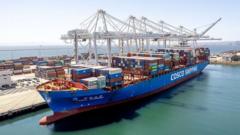The US Trade Representative has detailed a plan to impose port fees on Chinese vessels, set to commence in 180 days, as part of a broader strategy to revive American shipbuilding and reduce reliance on China.
US Proposes Port Fees on Chinese Ships to Boost Domestic Shipbuilding

US Proposes Port Fees on Chinese Ships to Boost Domestic Shipbuilding
New measures aim to challenge China's shipping dominance while impacting global trade dynamics.
The US government has taken a definitive step towards reinforcing its domestic shipbuilding industry by announcing that it will implement port fees on Chinese ships. This initiative was unveiled by the US Trade Representative (USTR) as part of an ongoing effort to diminish China’s significant hold over the shipping sector. This latest plan denotes a more measured approach compared to an earlier proposal posted in February, which aimed to impose fees of as much as $1.5 million (£1.1 million) on each Chinese vessel visiting American ports.
The port fees will be instituted starting in 180 days and are expected to escalate over the following years. The USTR highlighted concerns that Chinese advancements in shipbuilding have severely disadvantaged American businesses, workers, and the economy. The new fees will be determined based on various criteria such as cargo weight, container counts, and vehicle numbers on board. Specifically, bulk vessels will incur charges of $50 per ton of cargo, increasing annually by $30 for three years, while container ships will be charged based on container volume. Fees for vehicles transported by Chinese built ships will begin at $150 each, with additional increments over subsequent years.
Moreover, exceptions will exist for certain vessels. Empty ships arriving at US ports for bulk exports, goods transported solely between American ports, and US and Canadian ships operating in the Great Lakes will be exempt from these fees. The USTR disclosed that a second wave of measures supporting US-built vessels transporting liquefied natural gas (LNG) is scheduled for implementation in three years, set to progressively increase over an extensive 22-year timeframe.
These measures are likely to have a ripple effect on global trade, as ongoing tariffs imposed by President Donald Trump have already begun to divert cargoes originally intended for the US to European ports. Trade organizations noted a significant escalation in US tariffs, which may reach up to 245% in some cases, exacerbating supply chain disruptions.
Leaders from the shipping and logistics sectors have expressed concerns about heightened congestion at ports in the UK and the EU due to redirected shipments. There has been a notable uptick in cargo imports from China into the UK and EU since the commencement of these tariffs, demonstrating a direct impact of the current trade policies. With ongoing tariffs quietly reshaping global shipping routes, industry experts emphasize that consumers in the US will likely bear the financial burden while European consumers remain relatively unaffected.
As global trade operations continue to evolve in light of these policies, companies may start rethinking their supply chain strategies to mitigate the disruptions caused by the tariffs and evolving port fee structures.
The port fees will be instituted starting in 180 days and are expected to escalate over the following years. The USTR highlighted concerns that Chinese advancements in shipbuilding have severely disadvantaged American businesses, workers, and the economy. The new fees will be determined based on various criteria such as cargo weight, container counts, and vehicle numbers on board. Specifically, bulk vessels will incur charges of $50 per ton of cargo, increasing annually by $30 for three years, while container ships will be charged based on container volume. Fees for vehicles transported by Chinese built ships will begin at $150 each, with additional increments over subsequent years.
Moreover, exceptions will exist for certain vessels. Empty ships arriving at US ports for bulk exports, goods transported solely between American ports, and US and Canadian ships operating in the Great Lakes will be exempt from these fees. The USTR disclosed that a second wave of measures supporting US-built vessels transporting liquefied natural gas (LNG) is scheduled for implementation in three years, set to progressively increase over an extensive 22-year timeframe.
These measures are likely to have a ripple effect on global trade, as ongoing tariffs imposed by President Donald Trump have already begun to divert cargoes originally intended for the US to European ports. Trade organizations noted a significant escalation in US tariffs, which may reach up to 245% in some cases, exacerbating supply chain disruptions.
Leaders from the shipping and logistics sectors have expressed concerns about heightened congestion at ports in the UK and the EU due to redirected shipments. There has been a notable uptick in cargo imports from China into the UK and EU since the commencement of these tariffs, demonstrating a direct impact of the current trade policies. With ongoing tariffs quietly reshaping global shipping routes, industry experts emphasize that consumers in the US will likely bear the financial burden while European consumers remain relatively unaffected.
As global trade operations continue to evolve in light of these policies, companies may start rethinking their supply chain strategies to mitigate the disruptions caused by the tariffs and evolving port fee structures.






















